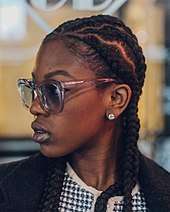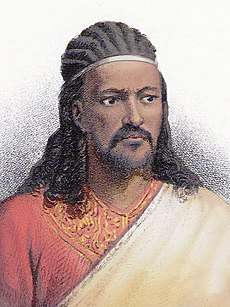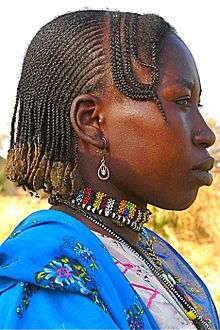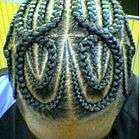Cornrows
Cornrows or African braids, also called canerows in Jamaica, are a style of hair braiding, in which the hair is braided very close to the scalp, using an underhand, upward motion to make a continuous, raised row.[1] Cornrows are often done in simple, straight lines, as the name implies, but they can also be formed in elaborate geometric or curvilinear designs.

Depending on the region of the world, cornrows are worn by men or women, or both, and are in few occasions adorned with beads, hair cuffs or cowry shells. The duration of weaving cornrow braids may take up to about 5 hours, depending on its quantity and width.[2] Often favored for their easy maintenance, cornrows can be left in for weeks at a time if maintained through careful washing of the hair and usual oiling of the scalp. Braids pulled too tight or worn for unreasonable lengths of time can cause a type of hair loss known as traction alopecia.[3]
History

Cornrows are a traditional way of styling hair in different global areas.[4] Depictions of women with cornrows have been found in Stone Age paintings in the Tassili Plateau of the Sahara, and have been dated as far back as 3000 B.C.[5]The traditional hairstyle of Roman Vestal Virgins incorporated cornrows.[6]
The tradition of female hairstyling in cornrows has remained popular throughout Native America, particularly in the east and south. Historically, male hairstyling with cornrows can be traced as far back as the early 5th century BC within Ancient Greek sculpture and artwork, typically shown on warriors and heroes. Artwork and statues of other middle-eastern and Mediterranean civilisations dating back to the 3rd and 4th century BC also suggest that such hairstyles were common amongst warrior cultures. More modern male depictions occur in the 19th century Ethiopia, where warriors and kings such as Tewodros II and Yohannes IV were depicted wearing cornrows.
Cornrow hairstyles in America also cover a wide social terrain: religion, kinship, status, age, racial diversity, and other attributes of identity can all be expressed in hairstyle. Just as important is the act of braiding, which transmits cultural values between generations, expresses bonds between friends, and establishes the role of professional practitioner.[7]
Cornrows made a comeback in the 1960s, 1970s, and 1980s, but returned during the 1990s, 2000s, and in the present day when NBA basketball player Allen Iverson repopularized this hairstyle.[8]
Controversy

Over the years, cornrows, along with dreadlocks, have been the subject of several disputes in US workplaces, as well as universities. Some employers and educational institutions[9] have considered them unsuitable, and banned them – sometimes even terminating employees who have worn them. Employees and civil rights groups have countered that such attitudes evidence cultural bias, and some disputes have resulted in litigation.[10]
In 2011, the High Court of the United Kingdom, in a decision reported as a test case, ruled against a school's decision to refuse entry to a student with cornrows. The school claimed this was part of its policy mandating "short back and sides" haircuts, and banning styles that might be worn as indicators of gang membership. However, the court ruled that the student was expressing a tradition and that such policies, while possibly justifiable in certain cases (e.g. skinhead gangs), had to accommodate reasonable racial diversities and cultural practices.[11]
Gallery
 Styled cornrows
Styled cornrows Cornrows
Cornrows Artistic braiding
Artistic braiding
References
- "History of Cornrow Braiding". Csdt.rpi.edu. Retrieved 20 June 2015.
- "Cornrow Braid Styles". Africanamericanhairstyling. Retrieved 11 August 2018.
- "Braiding 'can lead to hair loss'". BBC News. 24 August 2007. Retrieved 30 April 2010.
- Black & Beautiful Fashion (22 June 2016). "Do Cornrows Come from Africa?". Retrieved 12 August 2016.
- Willie F. Page, ed. (2001). Encyclopedia of African history and culture: Ancient Africa (prehistory to 500 CE), Volume 1. Facts on File. p. 36. ISBN 978-0816044726.
- "Oldest Roman Hairstyle Recreated for First Time". LiveScience. Retrieved 13 February 2019.
- "History of Cornrow Braiding: African Origins 1.b". Csdt.rpi.edu. Archived from the original on 23 June 2015. Retrieved 20 June 2015.
- Sherrow, Victoria (2006). Encyclopedia of Hair: A Cultural History. Greenwood Publishing Group. p. 97.
- Harris, Sherry. "Cornrows: History, Controversy & Freedom of Expression". Sherry's Life. Retrieved 28 August 2016.
- Alison Dundes Renteln. The Cultural Defense. p. 143. Retrieved 10 August 2011.
- "School braids ban 'not justified'". The Independent. 17 June 2011. Retrieved 17 June 2011.